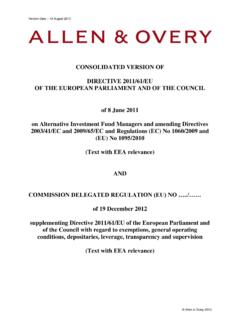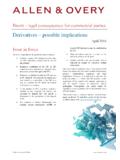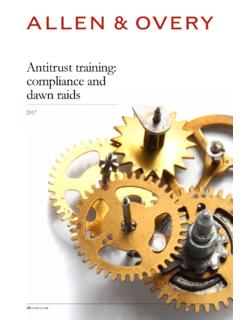Transcription of Securitisation a head start on the key considerations …
1 Allen & Overy LLP 2017 1 brexit legal consequences for commercial parties Securitisation a head start on the key considerations and possible implications May 2017 Issue in focus Notwithstanding that the EU ABS markets are significantly impaired compared to pre-financial crisis levels, Securitisation remains an important funding tool and risk-transfer mechanism for institutions established in the UK and elsewhere. This importance has been expressly acknowledged by the EU Commission in the context of its Capital Markets Union (CMU) initiative and the corresponding proposals to revive the markets through the introduction of a revised regulatory framework for Securitisation . Helpfully, the CMU initiative has largely remained on track despite the uncertainty added by brexit and there is some expectation that high-level political agreement will be reached within the next month or two, although a number of key issues remain unresolved at this point.
2 In this article we identify certain key considerations for securitisations arising as a result of brexit , and seek to provide a head start for our clients in analysing the possible implications . It should be noted that how the UK Government legislates for brexit and the nature of the future relationship between the UK and the EU are fundamental elements of the relevant analysis and may shape certain outcomes. In this regard, it is helpful that the UK Government is focused on the importance of maintaining legal certainty post-withdrawal, and the Great Repeal Bill, intended to plug the gap that would appear in the UK statute book if EU laws were allowed to fall away with brexit , brings some comfort of continuity. That said, the regulatory position of UK ABS post-withdrawal remains unclear in a number of respects.
3 This article is one of a series of specialist Allen & Overy papers on brexit . To access these papers, please visit brexit | Securitisation a head start on the key considerations and possible implications | May 2017 2 Allen & Overy LLP 2017 Key considerations and Analysis possible shifts in counterparty strength General concerns have been raised by a number of market analysts that the increased uncertainty arising as a result of brexit may lead to financial and economic volatility in the UK, which may in turn result in increased stress for UK market participants and a corresponding reduction in the financial strength of such entities. Some analysts have also predicted higher stress levels for UK institutions, particularly those less domestically oriented, as a result of brexit and the events leading up to it.
4 While securitisations are structured to mitigate possible risks arising in connection with the occurrence of a material event in respect of a transaction counterparty, perfect protection is elusive, and considerations may arise in particular in certain scenarios involving heightened levels of general economic stress and a corresponding (unanticipated) reduction in the credit of a key counterparty. In particular, the occurrence of certain related events upon a reduction in counterparty strength may give rise to a termination event in respect of the relevant counterparty. The analysis in this regard will turn on the relevant contractual provisions in respect of the Securitisation in question, as will the timelines and the obligations with respect to termination notices and finding a replacement counterparty if relevant.
5 Common termination events include insolvency-related events, although such termination may not be fully triggered until notice is provided by the issuer with the consent of the trustee or by the trustee. In general, whether parties can close out or terminate on insolvency may depend on the type of contract and the laws of the jurisdiction of the relevant insolvency proceedings. Trustees may be reluctant to exercise discretion in relation to contractual rights and remedies that have become exercisable following relevant termination events without direction from noteholders. A ratings downgrade may also constitute a termination event (requiring the positioning of collateral or replacement with a party with the requisite rating, which may be difficult) or, in the case of a seller downgrade, an event triggering the obligation to establish a reserve fund and/or a stop sale event (effectively making the asset pool static).
6 While transactions may anticipate and provide for back-up servicing arrangements (through the full positioning of a back-up servicer or the appointment of a back-up servicer facilitator) and/or other arrangements intended to mitigate the risk of counterparty default (in line with rating agency requirements or otherwise), it is difficult to confirm all arrangements would operate as intended and/or prove sufficient in a scenario involving wider financial and economic volatility issues. In general, in times of market turmoil, it may prove more difficult (and costly) in practice to find a suitable replacement for a counterparty, and in certain circumstances this may ultimately affect the Securitisation issuer s ability to meet its payment obligations in respect of the ABS.
7 It is also worth noting that not all counterparties may be replaced. Leaving aside the activities that the originator or seller may perform in its other capacities in the context of an ABS deal ( as servicer, cash manager, swap provider and/or account bank), the occurrence of certain events in respect of the originator or seller may have an impact on its ability to perform its obligations as seller and this is not a role likely to be undertaken by another party. For example, the seller may be unable to repurchase assets which breach the representations and warranties set out in the asset sale agreement. While securitisations are structured to provide for the ring-fencing of the securitised assets and the legal analysis will typically confirm that this should not be compromised by an insolvency event in respect of the originator, certain aspects of transactions may not play out as intended if the seller is no longer able to perform.
8 possible shifts in asset performance Certain market analysts have noted that brexit and events leading up to it may affect the UK housing and secured funding markets in particular, thereby possibly giving rise to shifts in the performance of related assets (such as UK residential mortgage loans). Any shifts in this regard may be relevant in the context of ABS backed by such assets. While the cashflows in brexit | Securitisation a head start on the key considerations and possible implications | May 2017 Allen & Overy LLP 2017 3 securitisations will be modelled to take into account expected stresses and default levels, extended periods of economic uncertainty and/or heightened volatility can challenge the assumptions applied.
9 Various factors are cited by analysts as possibly contributing to the relevant implications of brexit in this regard for underlying asset portfolios. These factors include (i) the level of geographical diversification (given possible increased relocation levels from London), (ii) the level of UK non-conforming and buy-to-let assets (given possible reductions in investment in the UK real estate market and possible property value evolution) and (iii) floating rate product concentration levels (given possible increases in interest rates). These asset performance and market-related predictions go beyond the scope of this article and its focus on legal consequences in general. However, it is worth noting that a market practice has developed since the referendum of including risk factor wording in prospectuses for UK ABS transactions to flag the uncertainty in this regard and certain related considerations .
10 This risk disclosure is necessarily set out in high level terms only as a reflection of the current lack of certainty and the resulting challenges to meaningfully identifying and articulating the corresponding risks at this point. We expect consideration to continue to be given to this practice in the context of UK securitisations on a case-by-case basis (particularly for transactions with a connection to the UK housing and secured funding markets). possible credit rating actions and eligibility implications Times of financial and economic volatility and any corresponding reduction in counterparty strength and/or underlying asset performance may result in a rating downgrade. In certain circumstances, counterparty-related events and/or material asset performance changes may result in rating action in respect of the ABS.















